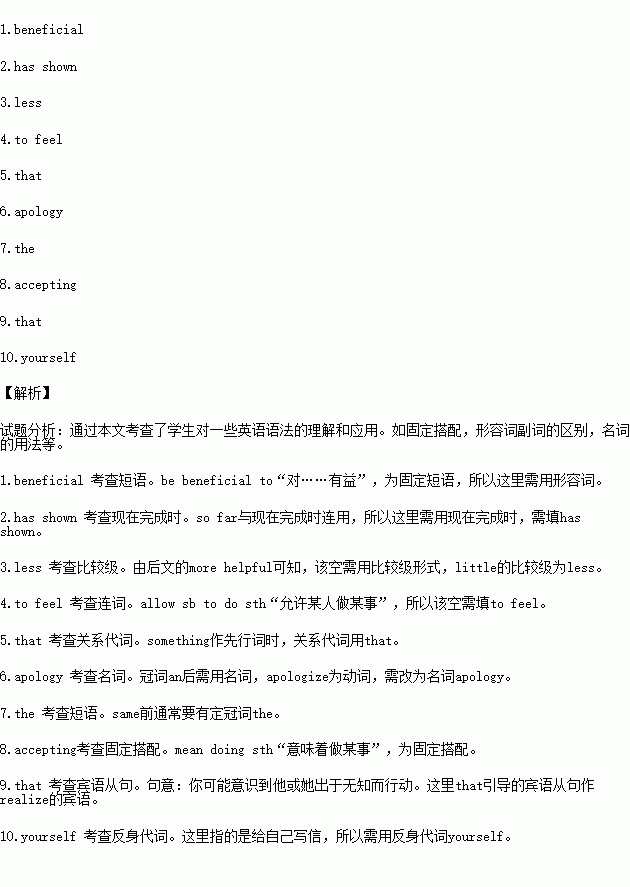题目内容
阅读下列材料,在空白处填人适当的内容(1个单词)或用括号内单词的正确形式。
When someone has deeply hurt you, it can be very difficult to let go of your anger. But forgiveness is possible — and it can be surprisingly 1. (benefit) to your physical and mental health. So far, research 2. (show) that people who forgive can have more energy, better appetite and better sleep. “People who forgive show 3. (little) anger and more hopefulness,” says Dr. Frederic Luskin, who wrote the book Forgive for Good. “So it can help reduce the tiredness out of the immune system and allow people 4. (feel) more energetic.”
So when someone has hurt you, cool down first. Take a couple of breaths and think of something _5. gives you pleasure: a beautiful scene in nature, or someone you love. Don’t wait for an 6. (apologize). “Many times the person who hurt you may never think of apologizing,” says Dr. Luskin. “They may have wanted to hurt you or they just don’t see things in 7. same way. So if you wait for people to say sorry, you could be waiting a very long time.”
Next keep in mind that forgiveness does not necessarily mean 8. (accept) the action of the person who upsets you. Instead, learn to look for the love, beauty and kindness around you. Finally, try to see things from the other person’s perspective. You may realize 9. he or she was acting out of ignorance. To gain perspective, you may want to write a letter to 10. (you) from that person’s point of view.
 一线名师权威作业本系列答案
一线名师权威作业本系列答案Step into Wonderland and follow any of the many tracks around Kinabalu Park. Even though it is the most explored and studied place in Borneo, new discoveries of rare plants are frequently being made here.
So take a map and set off on your own or follow Park Naturalists as they take you on guided path walks and point out the various wonders. There are also visual shows advertising rare plants and animals here. If you are a first time visitor, sign up for these shows and you’ll be excited when you find yourself identifying the same plants and animals on your walks or during your climb up Mt. Kinabalu.
Mt. Kinabalu Botanical Garden is one of the biggest attractions at the park, which started in 1981. This 5-acre garden is an excellent collection of different kinds of plants on the mountain, as plants from all over the park have been replanted here. There are hotels, inns and chalets(牧人小屋) at Kinabalu Park to suit one’s budget. For more information, click www.sabahtourism.com.
TIMETABLE GUIDE | |
PLACE / INTEREST | TIME (HRS) |
1. KINABALU PARK HQ: Botanical Garden Guided Walk Slide Show | 9:00—15:00 11:00 14:00 (and 19:30 on weekends) |
2. PORING Butterfly Farm Tropical Garden Night Walk | 9:00—16:00 13:30 By Prior (提前) Arrangement Only |
3. MESILAU Guided Nature Walk Monday to Friday Saturday and Sunday | 9:30, 11:00, 14:00 7:30, 10:30, 14:00 |
4. KUNDASANG WAR MEMORIAL Daily (Monday to Sunday) Memorial Services & Special Programs | 10:00—17:00 By Prior Arrangement |
Note: Adult: $20. Kid under twelve: 50% off Family including two adults and a kid under twelve: $40. | |
1.What can we infer according to this text?
A. There’re still some unknown rare plants in Kinabalu Park.
B. Mt Kinabalu is a more explored and studied area than Borneo.
C. Mt Kinabalu Botanical Garden attracts visitors due to its long history.
D. Visitors should follow the Park Naturalists so as not to get lost.
2.Which of the following is a fact based on this text?
A. Guided Nature Walk is a favorite of first time visitors.
B. Botanical Garden and Butterfly Farm open at the same time.
C. Slide Show is unavailable unless it is arranged in advance.
D. Visitors can have access to Night Walk anytime they wish.
3.If a couple visit the Park with their son aged 19, how much will they pay?
A. $30.B. $40.C. $50.D. $60.

